Old and new were interwoven in this concert presented by soprano Jennifer France and five members of the Britten Sinfonia, conducted by Jack Sheen. The ancient warp was the music of Hildegard of Bingen, the modern weft, three works characterised by colour and contemplation. The result was a sonic web of sound in time.
The achievements of Hildegard of Bingen encompassed music, poetry, theology, medicine and science. And, she certainly overturned the ‘neglected female genius’ trope. One of the earliest revivals of her music began in 1857 with the first modern performance of her ‘sequence’, O virga ac diadema (O branch and diadem) which the scholar and musician Ludwig Schneider transcribed from the Riesencodex (also known as the Wiesbaden Codex) so that it could be sung at a special service celebrating Hildegard’s own feast day on 17th September of that year.
Sequences are poetic and musical supplements to the liturgy, which are usually sung during the Mass, after the Alleluia. Their verse structure, built upon rhymed couplets, tends to make them quite formulaic, but not in Hildegard’s hands. She took advantage of the freeing of the text from any liturgical action at this point in the service to explore the textual imagery and elaborate it musically, often in complex ways. Such inventiveness and freedom might seem to invite re-interpretation and revisioning and this is how Jack Sheen responds in his three arrangements of Hildegard’s music that were presented at Wigmore Hall.
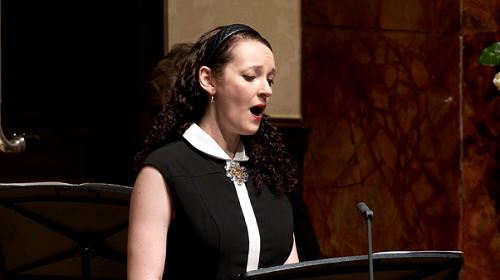
Such re-visiting presents two main challenges: how to preserve the expressive symbiosis of music and text, especially if what was originally a monodic vocal line, shaped by the text, is enlarged and the textures and timbres made more complex; and, how to conjure the spiritual mystery which Hildegard music embodies. With soprano Jennifer France assuming the duty of praising the Virgin’s royal status, redemptive role and procreative power, the presence and impact of the vocal celebration of Mary’s golden glory in Sheen’s arrangement was assured. Crystalline is a neatly apt term to encapsulate the synthesis of affective lyricism, sensitive articulation and celestial shine with which France communicated the intense textual imagery.
Recurring vocal motifs and textual images – the blossoming virga, the Virgin’s golden womb – were varied and heightened, and France built the strophes dramatically towards the reflections on Adam’s and Eve’s respective failings which resulted in the Fall from which the Virgin redeemed mankind. One of the most striking melodic gestures is the extension of the rising fifth interval which initiates so many of the vocal phrases, upwards to the octave – reaching a high A which France’s pristine precision invested with an almost unearthly power and glow. The sound was made into light: the divine light which shone from Mary’s golden womb.
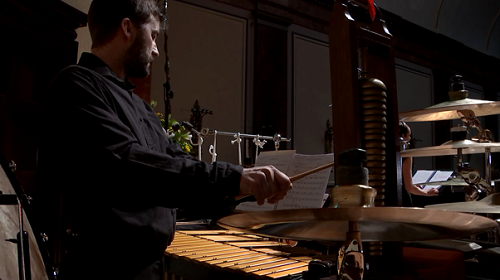
Sheen harnessed this climactic gesture, and its structural role, in his minimal but suggestive instrumental accompaniment. The sustained tonic, played by flute (Thomas Hancox), clarinet (Oliver Pashley) and cello (Caroline Dearnley), which conveyed unwavering belief in the salvatory Virgin, was first supplemented by the cor anglais’s (Peter Facer) gentle fifth degree; subsequently, more dissonant digressions by the clarinet and the vibraphone’s oscillations (Owen Gunnell) suggested the intrusion of lack of knowledge and loss into human experience as a result of Eve’s actions – “cum vulneribus ignorantie decerpsit, et plenum dolorem/ generi suo protulit” (with wounds of ignorance – the full inheritance of grief she offered to her offspring) – and the resulting guilt (“crimina”) and suffering.
France seemed genuinely and deeply moved by Hildegard’s musical mysteries. It’s a challenge, though, to truly conjure the spiritual within a secular space, unaided by the acoustical resonance created by ecclesiastical vaults, columns and niches, supplemented by persuasive architectural iconography, and a collective, congregational presence. But, here and in the antiphon, O frondens virga, and the responsary, O viriditas digiti Dei, the musicians sought and often found a sacred solemnity. Soft flute and cello, and fluttering cymbals introduced “O frondens virga”, establishing a delicately reverential mood and preparing for the modest address to Mary, the ‘blooming branch’. There are fewer rhetorical flourishes in this antiphon, and the register is generally low, but France captured the gravity of man’s appeal to the Virgin to “stretch forth your hand to lift us up aright” (atque manum tuam porridge ad erigendum nos), the vocal sincerity deepened by the harmonic cluster by which it was supported.
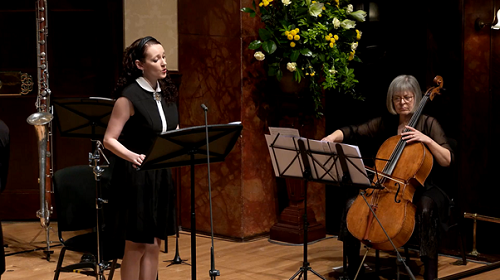
O viriditas digiti Dei is a responsary (usually sung as a musical postlude to the read lesson) in honour of Saint Disibod, Hildegard’s early patron, and alludes to Disibod’s establishment of a religious community (plantatio). But, it has a broader scriptural resonance, the textual imagery recalling Isaiah 40 which foretells that every valley shall be exalted: here Christ, who is the ‘greenness of God’s finger’ is sent to earth to sow and nurture the Christian Church. As in O virga ac diadema, the melody – introduced here by high cello, passed to the voice, and then coalesced in a pure unison – evolves and unfolds, accruing drama through melismatic development and registral extremes. France beautifully fused the human and celestial.
The young Oliver Knussen evidently had an affection for A.A. Milne’s Winnie-the Pooh. He drafted an early version of the Hums and Songs of Winnie-the-Pooh at the age of sixteen, and it was performed two years later. In a considerably revised and extended form, Hums and Songs Op.6 for soprano, cello, flute, piccolo, cor anglais, clarinet, bass clarinet and extensive percussion – including cardboard box, balloon and pin – was heard at the 1983 Aldeburgh Festival. The latter ‘instruments’ are a clue as to the narrative focus of Hums and Songs, although Knussen himself explained that ‘it isn’t exactly a setting of the episode with tree, bees and balloon’, rather it is ‘a sequence of faded snapshots and reflections, by an unwilling grown-up, on things remembered from the book, and on what those meant to him as a child.’
Scored with characteristic refinement and a kaleidoscopic palette, Hums and Songs presents a mosaic of moments of experience. In the opening ‘Aphorisms’, one simply wants to shut one’s eyes and relish Knussen’s miniature soundscapes which whisk the listener to an array of mistily remembered other worlds. The second movement, ‘Bees’, was a haze of buzzing and flickering – sul ponticello tremolos, flutter-tonguing, vocal hums and trills. The onomatopoeic pictorialisms are sometimes a tad too inevitable, but the instrumentalists’ virtuosity offered its own pleasures – though I did wonder if such virtuosity and whimsey are entirely convincing partners. The pathos and eloquence conjured by brief lyrical fragments, a soulful cello or plaintive cor anglais, were welcome. Sheen conducted with economy and precision.
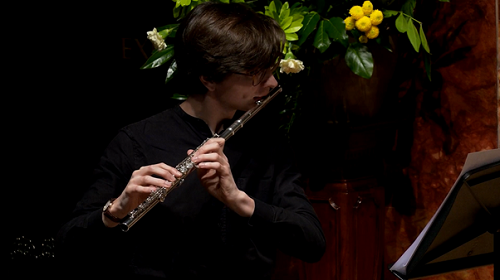
Given that much of the text consists of buzzes, hums and ‘nonsense’, France did well to articulate the snatches of brief poetry as clearly as she did, and in the more extended lyrical episodes – the climbing of the tree, the celebration of floating clouds – she captured the exhilaration and wide-eyed wonder of childhood vision and experience. She coolly ‘climbed the tree’ to its stratospheric heights – reaching the top F’s and Eb’s with astonishing grace – and was lifted heavenwards by Hancox’s guiding flute. ‘Pooh’s Fall’ was a beautiful ‘riot’ of tumbling woodwind, a headlong rush down a musical ski-slope which culminated in a tam-tam thump that was more humbling than humiliating. In the final hymn to floating clouds, France’s radiance was wonderfully assuaging.
Jürg Frey’s Circular Music No.2 develops gradually, each step a minor but meticulous modification. The sonorities are comforting, the slow, barely sensed pulse soporific but soothing. Gentle rumbles of the bass drum are juxtaposed with the dry rustle of crinkled, scrunched tin foil, evoking expanse. The musical ideas remain diffuse, never fully realised. The effect is an interplay of sound and silence which feels spontaneous and which foregrounds time, or rather ‘the present’. Repetitions feel somewhat arbitrary; the music could end at any moment and still feel ‘complete’.
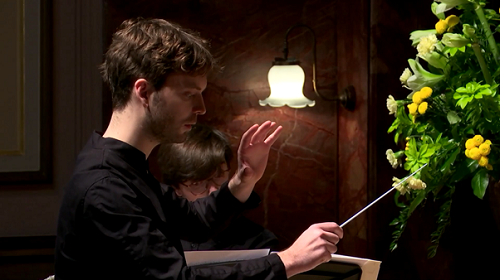
Placed centrally in the programme was the world premiere performance of Jack Sheen’s Hollow propranolol séance which the composer-conductor describes as a “heart-rate slowing hum”. Commissioned jointly by Wigmore Hall and the Britten Sinfonia, the work presents a delicate stream of rustles, raps and ripples which emerge from an empty ‘hollow’ to take tangible but tentative sonic form. Initiated by fanning cello pizzicatos, the jittery flute twitches and soft cymbal shimmers creep in, later to be cooled by the ethereal ring of floating string harmonics, warmed by restrained clarinet and cor anglais explorations, or calmed by murmuring vocalise. If there is ebb and flow it is tactile rather than kinetic: harmonic stillness juxtaposed with restless timbre. It’s all about sound: as if one is lost in the heart of darkness, where solitude magnifies aural sensation and sensitivity.
Propranolol is a beta blocker, designed to de-stress the heart and lessen anxiety. This concert’s slow progression through sounds spiritual, static and strange is guaranteed to lower the pulse and soothe the soul.
This concert is available for 30 days on demand, via the Wigmore Hall website.
Claire Seymour
Britten Sinfonia: Jack Sheen (conductor), Thomas Hancox (flute, piccolo), Peter Facer (cor anglais), Oliver Pashley (clarinet), Owen Gunnell (percussion), Caroline Dearnley (cello), Jennifer France (soprano)
Hildegard of Bingen – ‘O virga ac diadema’ (arr. Sheen); Oliver Knussen – Hums and Songs of Winnie-the-Pooh Op.6; Hildegard of Bingen – ‘O frondens virga’ (arr. Sheen); Jack Sheen (b.1993) – Hollow propranolol séance (world premiere); Hildegard of Bingen – ‘O viriditas digiti Dei’ (arr. Sheen); Jürg Frey (b.1953) Circular Music No.2
Wigmore Hall, London (live recording); broadcast on 18th January 2021.